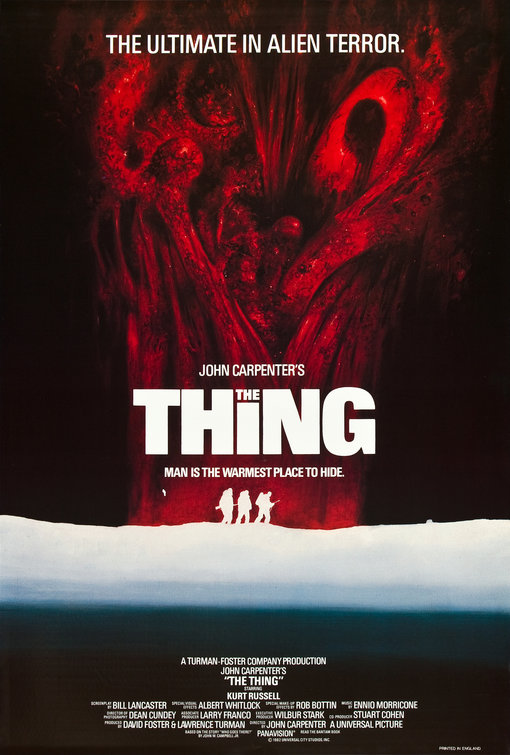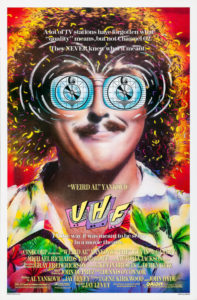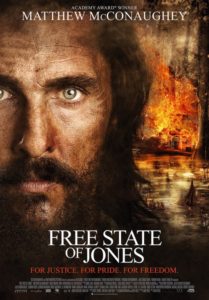Dr. Copper’s head, then his neck and shoulders began circling slowly in time to the words. Suddenly he was lying back on the bunk, roaring with laughter. ‘It doesn’t have to prove one of us is a monster! It doesn’t have to prove that at all! Ho-ho. If we’re all monsters it works the same! We’re all monsters - all of us - Connant and Garry and I – and all of you.”
“Who Goes There?” by John W. Campbell
I’m gonna hide this tape when I’m finished. If none of us make it, at least there’ll be some kind of record. The storm’s been hitting us hard now for 48 hours. We still have nothing to go on. One other thing: I think it rips through your clothes when it takes you over. Windows found some shredded long johns, but the name tag was missing. They could be anybody’s. Nobody… nobody trusts anybody now, and we’re all very tired. Nothing else I can do, just wait… R.J. MacReady, helicopter pilot, US outpost number 31.
John Carpenter’s “The Thing”
Spoiler Warning: This review goes into plot details and specifics of the film. If you haven’t seen this film and want to, proceed with caution.
Paranoia, survival, isolation: How do you trust the man standing next to you, when you can’t even be sure it’s a man? This is the question at the head of John Carpenter’s The Thing. The quote at the top is from the novella “Who Goes There?” which John W. Campbell published in 1938, and serves as the direct inspiration to both Carpenter’s film and Howard Hawks’ 1951 film The Thing from Another World. Carpenter was a big fan of both the story and the original film, and took inspiration from them in his early career. It’s a story that’s familiar to most sci-fi fans, basic but very effective. A group of American science workers in Antarctica come across an alien creature that can take over their bodies and create a perfect impersonation of them. With little time, they have to figure out which of them are people and which ones have been taken over, before they all become victims.
The Thing was a financial failure during its release in the Summer of 1982. Reviews weren’t much better. Horror magazine Cinefantastique went so far as to ask if it was “the most hated movie of all time?” Over time, however, the reputation of Carpenter’s film has improved immensely. Today, it stands at the very least as a cult classic, to many others a masterpiece of science fiction horror. Although this film is an adaptation of another story, it still feels uniquely otherworldly. To view The Thing is to invite yourself into its cold, bleak, and nihilistic world. This is by design, and is what makes The Thing truly special. Perhaps it caught on to the 80s attitudes towards the Cold War. Today, it remains as relevant as ever, with the idea of a virus-like alien under quarantine being frightfully prescient of today’s modern problem of the spread of a real-life virus.
From the very beginning, the audience is made to feel uncomfortable. With the opening credits set to a blank background, only brightened at the end to show the title card (an homage to the 1951 film) in the cold vacuum of space, an unwelcoming atmosphere is set. The haunting theme by the late Ennio Morricone completes this feeling. A flying saucer is shown crashing into Earth, and that is the only backstory given on the title monster’s origins. Nothing else matters, and in fact would detract from the terror to come. The film cuts to Antarctica in 1982, but we soon learn that this is at least one hundred thousand years later. A dog is the first character seen, with a pair of Norwegians in a chopper shooting at it close behind. It’s soon apparent that this dog is not what it appears to be, but when it finds refuge in an American science camp, the Norweigians are killed before they can explain what’s going on. This is a change from the novella, where the Americans just discover the Thing on their own, but it’s a smart change. In making the monster the first character on screen, but in the form of a cute dog, it plays up the alien as a manipulative force of nature, a master of infiltration. By proxy, it makes the main characters smarter, as they’re not actively seeking out their own doom. Instead, what’s happening is an unpredictable mystery thrust upon them.
A cast of 12 men are the only people who populate the rest of the movie. They are referred to by their last names for the most part. They may seem interchangeable at first, but an attentive viewer will learn who they are through osmosis (It helps that characters tend to say some names repeatedly at times). The film received criticism from Roger Ebert and Vincent Canby at the time for superficial characterizations, as if they were just props themselves. The script by Bill Lancaster does in fact develop its characters, but subtly, less through dialogue and more through action. With a cast of great character actors, including Wilford Brimley, Keith David, Richard Dysart, and future SAG President Richard Masur, the characters are given distinct personalities. They’re not particularly deep, but it’s clear in their interactions that they’ve worked together in this camp for a long time. Certain characters are treated differently from others, and they react to the terror amongst them in telling ways. Unlike some other horror movies, the men here act intelligently, keeping together and trying to enforce plans. With the exception of an out of place moment at the climax, the men move in groups, only making the mistake of splitting up before they realize what they’re dealing with.
This has nothing to do with the alien, he just learned he has diabeetus.The closest thing there is to a main character is MacReady (Kurt Russell). The casting here might betray that he’s supposed to be the hero, but it should be remembered that this was only a year after Carpenter successfully turned Russell into an action hero in Escape from New York. MacReady is charismatic, of course, but it’s subverted here. He’s introduced alone in his shack, drinking the time away and playing chess against a computer. After losing unfairly, he simply destroys it with his liquor. The relevance of this has been pointed out elsewhere, but it explains everything you need to know about him. MacReady starts off playing chess, and spends the rest of the film in a far more terrifying version of it. When he can’t win, or the opponent cheats, he just destroys the game. It becomes clear that this is an opponent he will have to outthink, but he struggles with a being with no apparent motive other than survival. At least one of them has been taken over, but how do you discover who if he’s a perfect replica, acting no differently from before?
In combating this threat, MacReady takes charge, but is no normal hero. He comes up with a couple ways to find the imposter, but implementing them is not easy, and the others come to distrust him more than each other. He eventually takes the others prisoner to run the tests, but the possibility of himself being infected remains. He even kills one of the others, and feels no noticeable guilt about it. This is where the more subtle characterizations work in the film’s favor. Only the basics of these people, and their relationships to each other, are known. Since they’ve only been seen during this conflict, paranoia runs rampant. We don’t know much about any of these people, making it easier to distrust them, even MacReady. The ones hiding the creature get infected at unknown times, and even the people who seem to be helping may have ulterior motives. With an enemy like this, destroying the game becomes the only option.
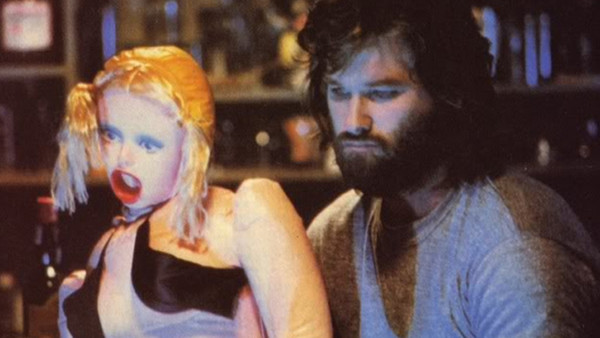
Much has been said of the special effects for the different versions of the Thing. The makeup and effects work by Rob Bottin, Roy Arbogast, and Stan Winston is masterful and unforgettable. Critics of the time accused them of overwhelming the film, but Carpenter was a filmmaker who understood that all the visual effects in the world are not a substitute for atmosphere. There are plenty of gross images and creatures, but they’re spread out and used when they are most effective. You don’t see them so much as to become desensitized. They are meant to scare the crap out of you, and they always do. The same design is never repeated. A dog opens up and sprays the other dogs around it, a stomach opens and mauls someone’s hands off, a head detaches and sprouts spider legs, and there are several other shockers. The effects are frightening, and frighteningly imaginative. Each time the Thing reveals itself, it reminds you of just how inhuman it is. As Chuck as SF Debris said, “It’s a monster that mocks our very idea of nature.” Every time these scientists learn something new about their foe, more questions are raised. The monster is scary because it’s so unknowable. Of course, if you watch this just say “It’s so gross, it’s awesome!” you are nevertheless watching this movie correctly.
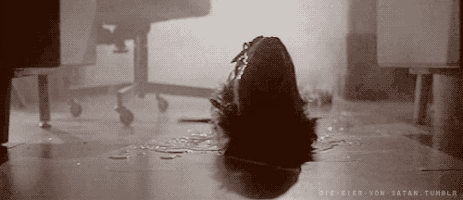
By the time The Thing leaves you, you’ve given up on the idea of a truly happy ending. The camp is wrecked, the survivors are freezing to death, and this Thing may or may not still be out there. It may even be one of the survivors. There is no final jump scare, no catharsis, no release. You get no answers for closure. The Thing’s abilities and nature remain largely undefined. You are left with the unknown. And that’s what’s most horrifying: the unknown.
GRADE: A
A couple of minor flaws can’t diminish the pure Eldritch horror of John Carpenter’s version of this story. This film is not for everyone, and that’s probably why it flopped. Critics and audiences were more interested in the optimistic sci-fi fare of that summer, such as E.T, Wrath of Khan, and even Poltergeist. Maybe this would have been more popular as a winter release. Nevertheless, The Thing remains a haunting classic. The feeling of terror grips you from the beginning and doesn’t let up even after the end credits. It also remains relevant to today’s struggles with COVID-19. It’s a great entry for the Summer Blockbusters That Weren’t, and has stood the test of time.

